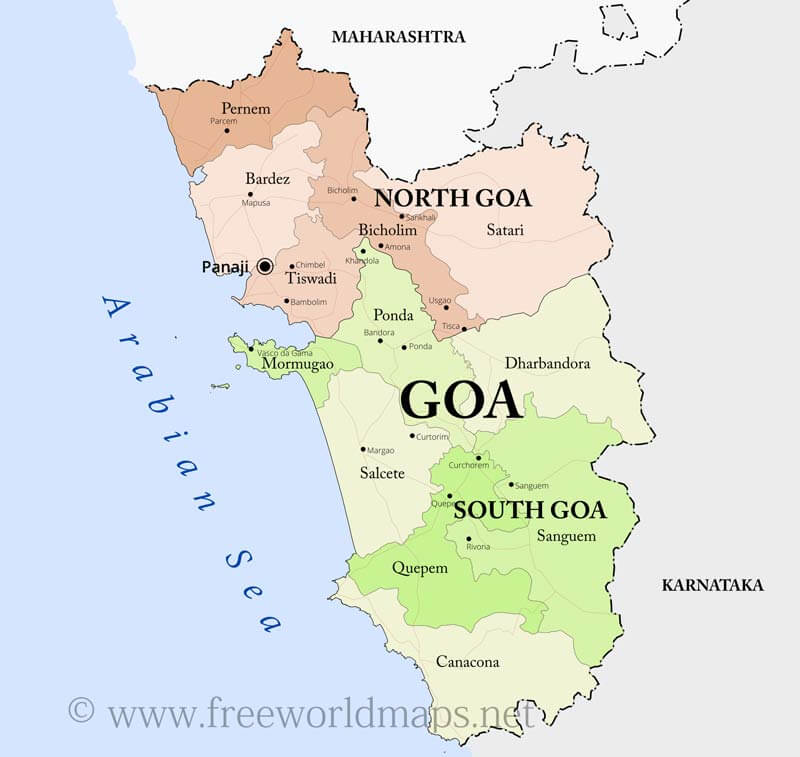
Goa’s climate is equable, with high temperatures generally in the 80s F (30s C) and low temperatures in the 70s F (20s C) throughout the year. A southwest monsoon blows between June and September. The state receives about 115 inches (3,000 mm) of rainfall annually, most occurring during the monsoon season.
The Portuguese colonial heritage and the diverse local population of Goa have cultivated a unique cultural
landscape. The population is primarily a mixture of Christians and Hindus: the western coastland and estuaries
are dotted with wayside crosses and Roman Catholic churches, while the hilly east is scattered with Hindu
temples and shrines. There is also a notable Muslim population in Goa, as well as smaller communities of Jains,
Sikhs, and practitioners of local religions. Portuguese was once the language of the administration and the
elite, and as part of that legacy, many Goans bear Portuguese personal names and surnames. Today, however, most
Goans tend to speak Konkani, Marathi, or English.
Old Goa, on the island of Goa, was once the hub of the region, but the city was decimated by war and disease in
the 18th century; for the most part, only its ruins remain. Since the mid-20th century, however, efforts have
been made to preserve Old Goa. Among the city’s most notable landmarks are the Basilica of Bom Jesus, which
enshrines the tomb of St. Francis Xavier, and the Se Cathedral, dedicated to St. Catherine of Alexandria. Both
were built in the 16th century, and, with several other churches of Goa, they were designated a UNESCO World
Heritage site in 1986.
There are three principal cities in contemporary Goa: Panaji (Panjim), Marmagao (Mormugão), and Madgaon
(Margão). Panaji was originally a suburb of Old Goa. Like its parent city, Panaji was built on the left bank of
the Mandavi estuary. Now a busy port city, it contains the archbishop’s palace, the government house, and many
markets. Marmagao, sheltered by a promontory and outfitted with a breakwater and quay, is one of the major ports
between Mumbai and Kozhikode (Calicut; in the state of Kerala). It specializes in the shipment of iron ore and
manganese. As Marmagao developed, so too did nearby Madgaon, with its industrial estate, cold-storage
facilities, and large produce market.
Over the course of Goa’s history, Portuguese rule and fluctuating economic conditions caused emigration on a
large scale. Many Goans have moved not only to other parts of India but also to the former Portuguese colonies
on the eastern coast of Africa.
Agriculture remains a mainstay of Goa’s economy, with rice, fruits (such as mangoes), coconuts, pulses (legumes), cashews, betel (areca nut), and sugarcane among the leading crops. Principal forest products include teak and bamboo. The state has an active fisheries industry along its coast, although sustainability has been a growing concern in the 21st century. The state exports a number of its agricultural commodities.
GGoa is rich in minerals. Mining began in the mid-20th century, and over the next few decades it emerged as a
central component of the state’s economy. Iron ore, manganese, and bauxite are among the primary products of the
industry. Especially since the late 20th century, however, the adverse environmental impact of opencast mining
has prompted heated controversy and intermittent government-mandated moratoria on production. Although new
environmental regulations were put into place in the early 21st century, mining remains a sensitive issue.
The service sector of Goa’s economy has increased in importance since the late 20th century. This is attributable largely to the rapid growth of the tourism industry. By the early 21st century, tourism constituted a significant segment of Goa’s economy, as the state’s long, sandy beaches, coastal vegetation, coconut palms, and unique hotels attracted large numbers of international and domestic visitors. The expansion of tourism, however, has raised concerns about preservation of the natural environment.
Goa is well connected to the rest of India—and the world—by road, rail, sea, and air. In Panaji there is a large bus terminal that adjoins the station on the Konkan railway. Completed in 1998, the Konkan railway runs along India’s western coast from west-central Maharashtra to southern Karnataka, where it links with the country’s southern railway. Another rail line connects the state’s primary port at Marmagao (via Madgaon) with the country’s southwestern rail system by way of Castle Rock (in Karnataka) in the Western Ghats. There is an international airport at Dabolim, near Panaji.
The structure of Goa’s government, like that of most other Indian states, is defined by the national
constitution of 1950. The governor is appointed by the president of India for a five-year term. Assisting the
governor is the Council of Ministers, which is headed by a chief minister and is responsible to the elected
Legislative Assembly (Vidhan Sabha).
Educational and training institutes range from primary schools to technical and collegiate institutions. Goa University (1985), one of India’s premier postsecondary institutions, is located at Bambolim, near Panaji. The National Institute of Oceanography (1966), which is famous for its oceanographic research and for its expeditions to Antarctica, is located at Dona Paula, on the far western tip of Goa Island.